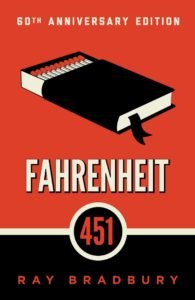Fahrenheit 451 Themes & Symbolism: A Guide
 1) The Hearth and the Salamander
1) The Hearth and the Salamander
Both the hearth and the salamander symbolize fire. A hearth is a fireplace and traditionally represents the home. In mythology, the salamander could live in fire and not be harmed. Salamander is also the name of Montag’s firetruck. The symbols are ironic. Montag does not live unharmed by fire as he realizes how burning books has ruined his society and that his society has ruined his home as evidenced by Mildred’s dependence on TV and sleeping pills.
- The Sieve and the Sand
The title of the second part of Fahrenheit 451 symbolizes Montag’s effort to learn as he reads (kind of like reading Shakespeare in your English class in the 8th grade). Sand is knowledge that eludes him. The sieve is his mind trying to make the knowledge permanent.
- The Phoenix
The phoenix is a mythological bird who bursts into flames at death and rises from the ashes born again. The phoenix represents Montag’s spiritual rebirth, society’s attempt to rediscover itself, and the cyclical nature of life.
- Mirrors
Granger suggests they build a giant mirror factory and take a look at themselves, which means he’s either really vain or he’s commenting on the importance of self-understanding. Clarisse is also compared to a mirror for helping Montag see himself. The intellectual Granger is probably familiar with Julius Caesar in which Brutus is counseled by Cassius to see himself as he is.
Want More Symbolism?
There are additional Fahrenheit 451 symbolism examples that appear throughout the novel.
- Blood - Blood symbolizes life or the lack of life. Montag’s revolutionary thoughts are most often accompanied by the increased flow of blood. Mildred’s poisoned blood is replaced by new blood after she attempts suicide; it, however, does not revive her soul and she remains dead inside.
- Fahrenheit 451 - The temperature at which books burn symbolizes the disintegration of Montag’s society. In essence, it’s the temperature at which society burns.
- Books - Faber explains the importance of books, that they represent the quality of life.
- Fire - Fire represents destruction, of books, of people, of society.
Fahrenheit 451 Themes
Study the following Fahrenheit 451 themes and impress your classmates. The Danger of Censorship Faber points out that people allowed censorship. Beatty tells Montag how censorship became necessary: “Don’t step on the toes of the dog lovers, the cat lovers, doctors, lawyers, merchant, chiefs, Mormons, Baptists, Unitarians, second-generation Chinese, Swedes, Italians, Germans, Texans, Brooklynites, Irishmen, people from Oregon or Mexico The bigger your market, Montag, the less you handle controversy.” (57). The problem with censorship is only those in power have access to knowledge, evidenced by Faber’s depth of literary knowledge, and claim it is there duty to make decisions for everyone. Faber reasons that if censorship is such a good thing then why are there so many suicides and why are they always at war. The Danger of Ignorance The fireman’s responsibility is to destroy knowledge and promote ignorance in order to ensure equality. Ignorance, however, promotes suicide, poor decisions, and empty lives. It also allows the government to do what it pleases. Faber explains, “If the government is inefficient, top heavy, and tax-mad, better it be all those than that people worry over it.” (61). Perhaps Bradbury saw that schools would someday spend three days on the Constitution and the Declaration of Independence while spending weeks on cutting out golden stars for National Wildlife Week and other government promoted events. The Danger of Information Overload In Montag’s society, schools no longer teach. They merely fill kids with knowledge and make them think they’re smart. Faber explains, “Cram them full of non-combustible data, chock them so damn full of facts they feel stuffed, but absolutely brilliant with information. Then they’ll feel they’re thinking, they’ll get a sense of motion without moving. And they’ll be happy because facts of that sort don’t change. Faber recognizes that lack of information is not the problem, knowing what to do with it is. What would he say about the Internet? For a review and a look at teaching <em>Fahrenheit 451</em>, follow the link.
References
- Bradbury, Ray. Fahrenheit 451. New York: Ballentine Books. 1978.
This post is part of the series: Fahrenheit 451 Study Guide
You can’t burn this study guide because it’s on the Internet. In your face, Beatty!
